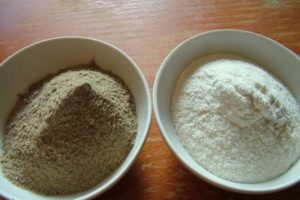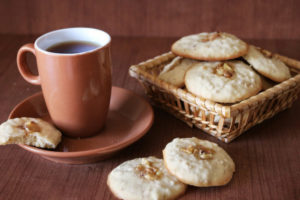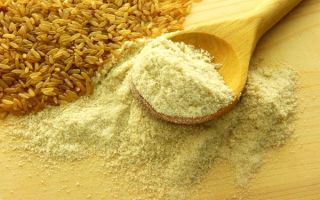Content
- 1 History of the origin of rice flour
- 2 Rice flour chemical composition
- 3 Nutritional value and calorie content of rice flour
- 4 Useful and medicinal properties of rice flour
- 5 Rice flour in diet food
- 6 Rice flour in baby food: benefit or harm
- 7 The use of rice flour in traditional medicine
- 8 Rice flour in home cosmetology
- 9 How to make rice flour at home
- 10 What can be made from rice flour
- 11 What can replace rice flour
- 12 Rice flour harm and contraindications
- 13 How to choose and store rice flour
- 14 Conclusion
- 15 Reviews
Rice flour is a great option for people who need to eliminate traditional wheat products from their diet. It is made by milling both white and brown rice. Its properties also vary depending on the starting material. It is not surprising that it is the basis for the national cuisine of Asian countries. Its beneficial properties contribute to the growth of popularity in other countries of the world. The benefits and harms of rice flour are the topic of this article.

History of the origin of rice flour
The cultivation of rice and the cultivation of various varieties date back to ancient times, when the cereal was considered a valuable commodity. Then the practice of using flour from it appeared. In the 1980s, this trend began to spread in the Western world, and soon, thanks to its beneficial properties, the substance became one of the main ingredients of cereals, chips, crackers, snacks and cookies.
Rice flour chemical composition
The most common types are brown and white. The health benefits of brown rice are due to the fact that the husk remains on the grains and this provides more fiber and several other nutrients.
|
Composition |
White rice |
From brown rice |
|
Manganese |
1.2 mg |
4 mg |
|
Vitamin B6 |
0.44 mg |
0.7 mg |
|
Selenium |
15.1 mcg |
— |
|
Niacin |
2.6 mg |
6.5 mg |
|
Thiamine |
0.13 mg |
0.45 mg |
|
Phosphorus |
98 mg |
337 mg |
|
Magnesium |
35 mg |
112 mg |
|
Pantothenic acid |
0.8 mg |
1.6 mg |
|
Copper |
0.13 mg |
0.26 mg |
|
Zinc |
0.8 mg |
2.5 mg |
|
Iron |
0.35 mg |
2.0 mg |
|
Potassium |
76 mg |
289 mg |
|
Vitamin E |
0.11 mg |
1.2 mg |
|
Choline |
5.8 mg |
— |
Thus, a brown grind is more beneficial and therefore more expensive.
Rice flour is gluten-free: it is an excellent substitute for wheat flour, which can be harmful to the body due to its gluten content, a protein that can irritate the digestive system. It is an excellent thickener and is perfect for making soups, sauces and gravies, and is often used to make flour products.
However, despite a rather impressive list of useful properties and benefits, it lacks nutrients that are found in more traditional varieties, and under certain conditions it can even harm the body.

Nutritional value and calorie content of rice flour
The calorie content of white rice flour per 100 grams is 366 kcal, and the brown one is 3 kcal less - 363. These indicators practically coincide with the calorie content of traditional wheat varieties. But in the proportions of BZHU in the composition of rice flour, the difference is really significant.
|
|
White rice |
From brown rice |
|
Carbohydrates |
80,1 g |
76.5 g |
|
Protein |
6.0 g |
7.2 g |
|
Fats |
1.4 g |
2.8 g |
|
Cellulose |
2.4 g |
4.6 g |
|
Water |
12 g |
12 g |
|
Ash |
0.6 g |
1.54 g |
Useful and medicinal properties of rice flour
The benefits of the product are due to the content of a significant amount of vitamins, minerals and other useful substances.
- It has a positive effect on the proper functioning of the liver. A study published in the International Journal of Experimental Pathology reports that a lack of choline causes liver fibrosis. Choline helps to flush out harmful cholesterol and fat from the liver and is therefore a great way to keep your liver healthy.
- The high level of dietary fiber, which is simply necessary to remove harmful substances from the body, can also be attributed to the indisputable benefit. Also, fiber has properties to lower bad cholesterol and normalize sugar levels. And this can help reduce the risk of colon disease and hypertension.
- Gluten-free grinding is great for people who cannot consume gluten and people who just want to eliminate gluten. For people diagnosed with celiac disease, eating gluten will harm the immune system, so rice bread and baked goods are almost the only alternatives to wheat and rye.
- The copper content has a beneficial effect on the work of the cardiovascular system and leads to a normal blood composition.
Rice flour in diet food
Rice flour is indispensable for diet and healthy eating. It is beneficial by normalizing metabolic processes and cleansing the body of toxins. Fiber not only has the ability to absorb harmful substances and subsequently remove them from the body, but also collects food residues that have not been digested. Therefore, rice flour is an excellent option for losing weight; it will be of great benefit to people who want to lose extra pounds, and adherents of healthy wholesome nutrition.

Rice flour in baby food: benefit or harm
Manufacturers include it in infant formula and cereals. Firstly, it has the property of a thickener that will not bring the slightest harm to the child's body. Secondly, it promotes the breakdown of fructose into glucose, preventing digestive disorders due to the high content of natural sugars in fruit mixtures. And, thirdly, it contributes to better absorption of nutrients obtained from the use of mixtures.
Today, the overwhelming number of foreign manufacturers use the product in the production of baby food, but on the domestic market - only a few. However, the absence of harm and risks of rice flour for infants, as well as a number of useful properties, contribute to its popularization as an ingredient in baby food and among domestic manufacturers.
The use of rice flour in traditional medicine
Although the product is mainly used as a food ingredient, it also has medicinal properties that have been beneficial in many Asian countries for centuries.
- Rice has a strengthening property, that is, it will be useful for people with chronic indigestion.
- A compress made from grind cooked in vinegar will help with bruises, dislocations, and insect bites.
- Milled rice cooked in melon juice will help get rid of freckles and age spots.
Rice flour in home cosmetology
Rice flour is often used to make facial products. This is a fairly popular ingredient for making homemade beauty masks. It has the ability to absorb impurities, harmful substances, and rice flour will help get rid of wrinkles and skin imperfections.
Rejuvenating facial mask with rice flour
This mask is beneficially applied against wrinkles.
Components:
- main ingredient - 2 tbsp. l .;
- honey - 1 tsp;
- olive oil (almond can be used) - 2 tsp;
- sour cream or heavy cream.
Application:
- Stir honey and butter until smooth.
- Add grind and dilute with sour cream or cream until a thick cream consistency.
- Apply to face and décolleté for 15-25 minutes.
- Repeat 2-3 times a week for a month.
Nourishing & Whitening Face Mask
Thanks to the smallest granules, ground rice easily exfoliates dead skin cells, this useful property is used in the preparation of whitening masks.
Scrubs with rice flour for face and body
Thanks to its structure, wonderful scrubs are obtained from the beneficial substance.
For hands
Components:
- main ingredient - 1 tbsp. l .;
- water - 2 tbsp. l .;
- cosmetic oil - a few drops.
Application:
- Stir all ingredients.
- Apply to skin and massage a little.
- Wash off with water.
For body
The skin on the body is softer than on the hands, so the scrub should be softer: 1 tbsp. l. grinding you need to take 4 tbsp. l. water, add a little more cosmetic oil and a single serving of shower gel.
Rice flour hair shampoo
For hair, the substance will also be very useful due to its adsorbing properties.
You can use it with benefit in the following ways:
- Using rice water to rinse your hair after washing. To do this, pour water over the rice and leave for 2-3 days.
- Use as dry shampoo (especially for blonde hair).
- Preparation of a mixture for washing hair: 3-5 tbsp. pour spoons of ground rice with warm water and stir to a liquid consistency. Apply to hair starting from the roots. Leave on for 2-3 minutes. to saturate hair with useful substances. Rinse thoroughly with a solution of water and lemon juice (for 1 liter of water, 1 tablespoon of lemon juice).
How to make rice flour at home
You can move on to a healthier, healthier diet by making rice flour at home. This requires a high-power blender or a professional food processor to place the rice grains and grind.
Hand-made rice flour will save not only the time required to find it, but also about 50% of its cost.
However, making such a powder is not difficult at home either. To do this, you need to grind premium rice and sift thoroughly. Apply to face like regular powder.

What can be made from rice flour
Basically, it is an ingredient for making bread, noodles and sweets.
- The Japanese use it to make their favorite national sweet - mochi.
- In China, it is used not only for baked goods and sweets, but also for wine production.
- In India, it is the basis for the preparation of idli (national flatbread), dosa (thin crunchy pancakes) and gulab jamun (sweet balls).
As it spreads to different parts of the world, the number of recipes using flour increases, and traditional dishes take on new notes.
What can replace rice flour
If the grinding goes as an additive, it can be replaced with starch, but if it is the main component of the dish, as in Vietnamese pancakes, then there is no replacement. However, the possibility of preparing the product at home reduces the urgency of the problem.
Rice flour harm and contraindications
With all the useful properties of grinding, its harm, even potential, has not been recorded. However, it's worth noting that gluten-free foods contain less protein, fiber, and minerals, and also have a higher glycemic index than some gluten-free foods.
Rice flour has a rather high glycemic index of 70 units, so you should not use rice flour even with diabetes: there is a danger of causing even more harm to the body.
How to choose and store rice flour
By its external properties, it is quite possible to determine a quality product: fine grinding, crumbly homogeneous consistency, neutral taste and smell. When choosing a packaged product, attention should be paid to the integrity and tightness of the package.
Store the substance in an airtight container to prevent mold infestation and the absorption of excess moisture. The shelf life of milling of white rice is not limited, but of brown rice is 5-6 months.
Conclusion
The benefits and harms of rice flour are mainly related to the lack of gluten in plant protein. That is why it is widely used in cooking, dietary and baby food, home cosmetology and traditional medicine. In the domestic market, both demand and supply for this useful product are still not too high, but there is a tendency to popularize it and include it in the daily diet.

